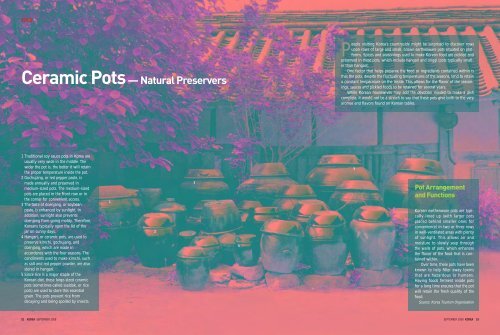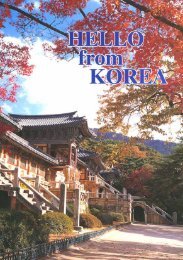Download - Korea.net
Download - Korea.net
Download - Korea.net
- No tags were found...
Create successful ePaper yourself
Turn your PDF publications into a flip-book with our unique Google optimized e-Paper software.
FOOD<br />
Ceramic Pots — Natural Preservers<br />
People visiting <strong>Korea</strong>’s countryside might be surprised to discover rows<br />
upon rows of large and small, brown earthenware pots situated on platforms.<br />
Spices and seasonings used to make <strong>Korea</strong>n food are pickled and<br />
preserved in these pots, which include hangari and onggi (pots typically smaller<br />
than hangari).<br />
One factor that helps preserve the food or ingredients contained within is<br />
that the pots, despite the fluctuating temperatures of the seasons, tend to retain<br />
a constant temperature on the inside. This allows for the flavor of the seasonings,<br />
sauces and pickled foods to be retained for several years.<br />
While <strong>Korea</strong>n housewives may add the devotion needed to make a dish<br />
complete, it would not be a stretch to say that these pots give birth to the very<br />
aromas and flavors found on <strong>Korea</strong>n tables.<br />
1 Traditional soy sauce pots in <strong>Korea</strong> are<br />
usually very wide in the middle. The<br />
wider the pot is, the better it will retain<br />
the proper temperature inside the pot.<br />
2 Gochujang, or red pepper paste, is<br />
made annually and preserved in<br />
medium-sized pots. The medium-sized<br />
pots are placed in the front row or in<br />
the corner for convenient access.<br />
3 The taste of doenjang, or soybean<br />
paste, is enhanced by sunlight. In<br />
addition, sunlight also prevents<br />
doenjang from going moldy. Therefore,<br />
<strong>Korea</strong>ns typically open the lid of the<br />
jar on sunny days.<br />
4 Hangari, or ceramic pots, are used to<br />
preserve kimchi, gochujang, and<br />
doenjang, which are made in<br />
accordance with the four seasons. The<br />
condiments used to make kimchi, such<br />
as salt and red pepper powder, are also<br />
stored in hangari.<br />
5 Since rice is a major staple of the<br />
<strong>Korea</strong>n diet, these large-sized ceramic<br />
pots (sometimes called ssaldok, or rice<br />
pots) are used to store this essential<br />
grain. The pots prevent rice from<br />
decaying and being spoiled by insects.<br />
1<br />
2<br />
3<br />
4<br />
5<br />
Pot Arrangement<br />
and Functions<br />
<strong>Korea</strong>n earthenware pots are typically<br />
lined up (with larger pots<br />
placed behind smaller ones for<br />
convenience) in two or three rows<br />
in well-ventilated areas with plenty<br />
of sunlight. This allows air and<br />
moisture to slowly seep through<br />
the walls of pots, which enhances<br />
the flavor of the food that is contained<br />
within.<br />
Over time, these pots have been<br />
known to help filter away toxins<br />
that are hazardous to humans.<br />
Having foods ferment inside pots<br />
for a long time ensures that the pot<br />
will retain the fresh quality of the<br />
food.<br />
Source: <strong>Korea</strong> Tourism Organization<br />
52 KOREA SEPTEMBER 2008<br />
SEPTEMBER 2008 KOREA 53

















